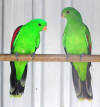. red winged parrot

Aviary Notes: Level Of Knowledge Required: Beginner / Intermediate / Advanced / Specialist Breeders Only. Government Regulations & By-Laws: Refer to " Government Laws " web page. Housing Requirements: Refer to " Housing Birds " web page for general details on the housing of Australian Parrots or read on for specific details for this parrot. Minimum aviary length should be about 3000 mm (10 feet) long. An aviary of 4 metres long will allow these birds to be able to get adequate exercise. The aviary should be about 1.2 metres (4Feet) wide and about 2.1 metres (4Feet) high. Up to 6 metres long if available. The Crimson winged parrot or Red winged parrot is a flighty bird and likes the aviary to have more privacy than most of the other more "domesticated" species. These birds generally do not thrive or breed in a suspended cage. Generally best if housed as one pair per aviary. Non-toxic leafy branches, such as eucalypts, can be placed in the aviary for the birds to chew up. This will entertain the birds, help minimize boredom and give the birds some beak exercise. Natural branches of various diameters, and placed at various angles, can be used for perches. These natural perches may be chewed by the birds and may need to be replaced regularly. The birds may chew any flowers and fruiting bodies on the branches. Diet / Feeding: Refer to " Feeding Birds " web page for general details on the feeding of Australian Parrots or read on for specific details for this parrot. Natural diet of the Crimson winged parrot or Red winged parrot in the wild includes seeds, fruits, berries, nuts, buds, blossoms and other vegetable matter. Insects may form part of their natural food intake. Basic seed is Small parrot mix or Budgie mix with sunflower seed, safflower and plain canary seed. A variety of fruits, nuts, green leafy vegetables, and a variety of seasonally available vegetables are essential in a balanced diet. Corn-on-the-cob is a parrot favourite. Sprouted seed or soaked seed if available. Seeding grasses will be eagerly devoured. Fruits and vegetables can make up more than 50% of the birds daily food intake. Seasonally available fruits and vegetables as well as thawed frozen vegetables should be offered to the birds each day. Vegetables to include green leafy vegetables such as silverbeet, spinach or endive. Good quality dry dog food can be offered. Wholemeal or multigrain bread can be offered. Some birds will consume insects such as mealworms, especially if they have young in the nest. The mealworm larvae, pupa and beetle can be offered. The insects provide a good source of easily digested protein. Commercial parrot pellets can form part of a balanced diet. Nesting: A basic overview only. Dimensions are typical / average and can vary widely, influenced by the owner's preferences and the birds preferences. Parent bird's preferences can also be influenced by the size and type of nest-box / log in which the bird was hatched and reared. If space allows, offering a choice of sizes and types of logs or nest-boxes, and placed in various locations within the aviary, can allow the parent birds to make their own choice. Once a pair has chosen a specific nest-box/log and been successful in it, offer that one to them each breeding season. Try and keep that one for their exclusive use. Once a pair has chosen its log or nest-box, the other ones can generally be removed. If the "spare" boxes are to be removed and moved to another flight, ensure the log / nest box is cleaned to ensure the receptacle has the minimal contamination of mites, parasites and pathogens. All Australian parrots will breed in hollow logs.
Timber nest-boxes generally require a climbing structure attached inside the box below the entrance hole. Both logs and nests need an entrance hole/opening about 100mm (about 4 inches) from the top. Many species of parrots like the entrance hole to be just big enough to squeeze through. More details on parrot nestboxes/logs and a selection of parrot nestbox/log photos can be found on the "nests", "parrot nests" and "parrot nestbox photos" web pages. Click on "Up" then "Nests" then "parrot nests" and "parrot nestbox photos" in the navigation bars. Breeding: Egg Colour White. Clutch/s per year 1 or 2. Eggs per nest 4 - 6. Incubation approx. 20 days. Fledge approx. 5 weeks. Independent approx. another 2 - 3 weeks. Crimson winged parrot or Red winged parrot is generally best housed as one pair per aviary. The cock bird can be aggressive during the breeding season. Young Crimson winged parrots should be removed from the parent birds as soon as they are fully independent so as to avoid possible aggression from a parent. In an aviary, the young birds just after they leave the nest are often "clumsy" fliers and may crash into the front wire wall. The placement of hessian on the outer side of the wire wall or leafy branches close to the wire inside the cage should minimize the risk of injury of a young bird. The young bird should see the hessian or leafy branches and not fly into the end of the aviary. Artificial incubation and hand rearing or fostering will not be covered on this web site. It is too complex and diverse in nature to be attempted here. Health Issues: Refer to "Avian Health Issues" web page for information and references.
General References: Refer to references listed on "Book References" web page. Specific References:
|